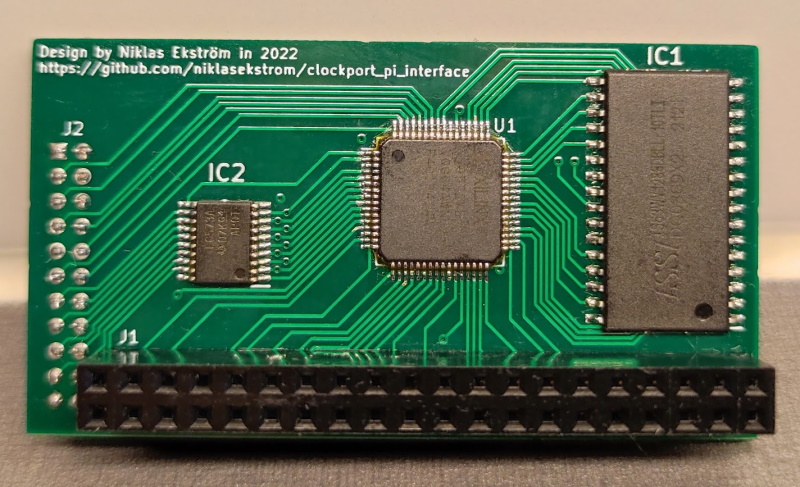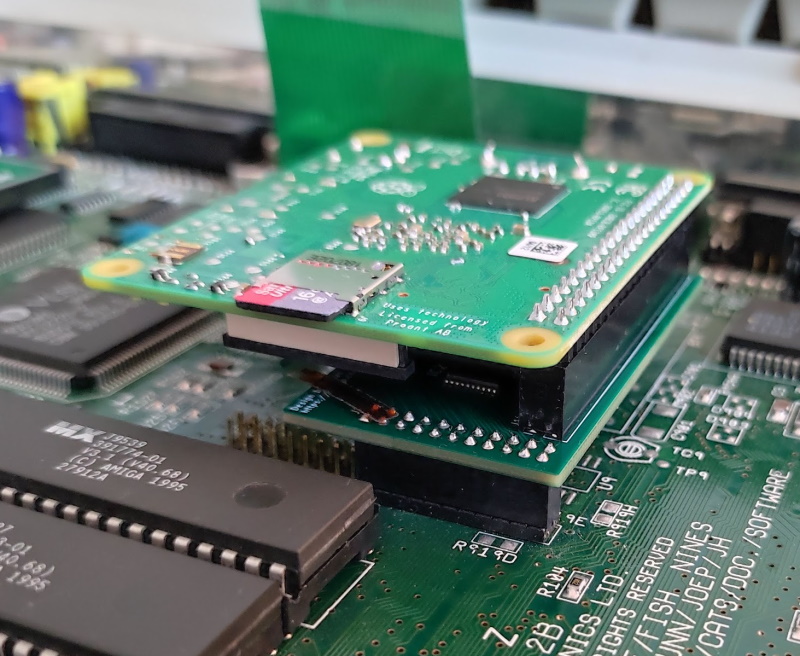
 |
|
|
#21 | |
|
Registered User
Join Date: Feb 2015
Location: Sweden
Age: 50
Posts: 2,946
|
Quote:
But sure enough, if RBPiZero is a poor match and some other solution is better that that would be the preferred option. But since no such solution seems to exits anyway, it probably means the software side of it is a mountain too high to climb. The work needed for drivers on both sides (Amiga, RBPi/other solution) isnt gonna magically appear (Looking at you Google code generating AI  ) )
|
|
|
|
|
|
#22 | ||
|
Registered User
Join Date: Apr 2018
Location: Stockholm / Sweden
Posts: 129
|
Quote:
Quote:
Building an interface card using a CPLD and maybe some memory doesn't sound hard, but of course someone still has to put in the time to actually design and build it, or else it won't happen. |
||
|
|
|
|
#23 | |
|
Registered User
Join Date: Sep 2013
Location: Poland
Posts: 806
|
@eXeler0
Quote:
@Niklas - yes, but your design access memory nearly directly and with full width (16bit data path) while you can't do that with clockport devices. I guess it would take an ugly wrapper first to make it "fairly straight-forward" to adopt drivers from your project. When you think about that then one fairly straight-forward solution would be to dump clockport altogether and make card (for A1200 and CD32 which doesn't have chip ram add-on) with fastram and use RAM buffer located at some part of ranger mem (so it wouldn't collide in any 3rd party software) to share data between RPi and Amiga. That'd also allow full 32bit access for full 32b 68k making it even faster (and not constrained by chipset timing). But with that - you're just one step from PiStorm. |
|
|
|
|
|
#24 | |
|
Registered User
Join Date: Feb 2015
Location: Sweden
Age: 50
Posts: 2,946
|
Quote:
yea, availability is shit right now, but you suggest pistorm as a better alternative and that is not available at all for A1200 afaik?  I did manage to buy a couple of pi zeros for rgb2hdmi projects a while ago however, and it was at normal price, but yea, situation isnt good atm. |
|
|
|
|
|
#25 |
|
Registered User
Join Date: Jun 2009
Location: Dublin, then Glasgow
Posts: 6,334
|
To be fair, availability problems are across the board - a semi-custom device using a microcontroller or even a CPLD + USB controller for example is likely to be affected by chip availability too, so it's in no better a state than the Pi Zero in that regard.
|
|
|
|
|
#26 | |
|
Registered User
Join Date: Sep 2013
Location: Poland
Posts: 806
|
@eXeler0
Quote:
@Daedalus - yes, many chips are hardly available nowadays but while there's no good alternative for RPi you can get plenty of chips having similar features from different vendors. So it's not a single source solution. Same goes with FPGA - you work on Intel devices and they become scarce? You can swap to Xilinx or Lattice or some smaller companies as well. When it comes to ARM SoCs... it's either Broadcom which is fairly powerful and cheap or things like i.MX with decent documentation, but expensive and lacks performance or things like Allwinner which is powerful but lacks proper documentation, or Rockchip which has documentation, is powerful but costly. BTW I don't really care all that much about IC shortages etc. It'd be good opportunity for the world to to reevaluate usage of microchips and how much of it goes to silly consumer electronics you can live without. |
|
|
|
|
|
#27 | |
|
Registered User
Join Date: Apr 2018
Location: Stockholm / Sweden
Posts: 129
|
Quote:
|
|
|
|
|
|
#28 | |
|
Thalion Webshrine
Join Date: Jan 2004
Location: Oxford
Posts: 14,331
|
Quote:
|
|
|
|
|
|
#29 | ||
|
Registered User
Join Date: Jun 2009
Location: Dublin, then Glasgow
Posts: 6,334
|
Quote:
Quote:
|
||
|
|
|
|
#30 | |
|
Registered User
Join Date: Sep 2013
Location: Poland
Posts: 806
|
Quote:
We've been rather carefree in how we use our resources and energy... it's going to change, rather sooner than later. This crisis is just contributing factor to re-evaluate some things and that's also going along with UE policy regarding electronic device longevity, repairs etc. BTW Amiga does not contribute to e-waste  Far from that. Far from that.
|
|
|
|
|
|
#31 | |
|
Registered User
Join Date: Apr 2018
Location: Stockholm / Sweden
Posts: 129
|
Quote:
I read this article, https://www.suse.com/c/cpu-isolation...xample-part-5/, and it seems to say that it is possible to isolate a CPU core and run a single task on that core, and that task gets to run uninterrupted. However, at the end of the article it says: "Note this desired result only happens with ideal settings on a perfect machine in a perfect world. Random noise is likely to be found on the trace and therefore the next article will be about disturbance chasing and troubleshooting." This makes me a bit suspicious that it may not work fully in practice. So maybe a CPLD is still good to implement the synchronous interface towards the Amiga. |
|
|
|
|
|
#32 |
|
Registered User
Join Date: Sep 2013
Location: Poland
Posts: 806
|
Linux - not really, bare metal - probably. As you said - it's better to access SRAM when amiga isn't and use that small 64K space for data exchange. It ain't that bad. NeoRAM for C64 uses 256B! And it can have 0,5-2MB of RAM! That's how small the window for data exchange is. 64K is capacity-wise rather ok but 8bit interface is limiting a lot. Especially when your CPU has 32b data bus.
|
|
|
|
|
#33 | |
|
Registered User
Join Date: Jun 2009
Location: Dublin, then Glasgow
Posts: 6,334
|
Quote:
|
|
|
|
|
|
#34 | |
|
Registered User
Join Date: Apr 2018
Location: Stockholm / Sweden
Posts: 129
|
Quote:
 Here's a possible layout for such an interface board. U1 is XC9572XL, IC1 is IS63WV1288DBLL-10TLI, IC2 is SN74LVC573APWRE4. Component cost perhaps around €30. 
|
|
|
|
|
|
#35 |
|
Hardware Designer
Join Date: Aug 2018
Location: Bialystok/Poland
Age: 50
Posts: 178
|
|
|
|
|
|
#36 |
|
Registered User
Join Date: Feb 2015
Location: Sweden
Age: 50
Posts: 2,946
|
|
|
|
|
|
#37 |
|
Registered User
Join Date: Apr 2018
Location: Stockholm / Sweden
Posts: 129
|
I uploaded my attempt at a design here: https://github.com/niklasekstrom/clockport_pi_interface. It's currently a PCB and Verilog for the CPLD. There is no software yet, but the design is similar to A314, so if it gets built it should be straight-forward (Promilus
 ) to adapt the software to it. ) to adapt the software to it.
|
|
|
|
|
#38 | |
|
Registered User
Join Date: Feb 2015
Location: Sweden
Age: 50
Posts: 2,946
|
Quote:

|
|
|
|
|
|
#39 |
|
Hardware Designer
Join Date: Aug 2018
Location: Bialystok/Poland
Age: 50
Posts: 178
|
You need some simple hardware for interfacing, and then FIQ (fast interrupt) on the Raspberry is fast enough to handle clockport read cycle. It assumes bare metal of course.
|
|
|
|
|
#40 |
|
Registered User
Join Date: Apr 2018
Location: Stockholm / Sweden
Posts: 129
|
I soldered up my design and adapted the A314 software for it. It works well! The design, including software, is available on GitHub.
  I only had a Pi 3A at home, but a Pi Zero 2W would obviously fit best. Promilus, here's the changes needed to adapt the disk service, it's 10 lines added and 17 lines deleted. |
|
|
| Currently Active Users Viewing This Thread: 1 (0 members and 1 guests) | |
| Thread Tools | |
 Similar Threads
Similar Threads
|
||||
| Thread | Thread Starter | Forum | Replies | Last Post |
| Raspberry Pi Pico as Akiko on Clockport | Gorf | Hardware mods | 56 | 12 August 2021 17:15 |
| Raspberry Pi Mini to 1200 Clockport Advice | betajaen | Hardware mods | 33 | 06 August 2018 11:38 |
| A600 Clockport | Lemaru | Hardware mods | 2 | 16 April 2018 18:46 |
| 4-way clockport expander | DJBase | Hardware mods | 231 | 09 January 2017 17:52 |
| Clockport switcher | thinlega | Amiga scene | 0 | 22 April 2003 22:01 |
|
|